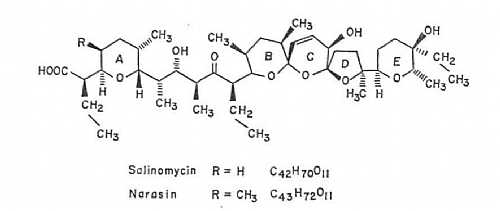|
Description: |
Narasin belongs to the polyether monocarboxylic acid class of ionophores.
|
||
| Origin: |
Fermentation product of Streptomyces aureofaciens.
|
||
| Mode of Action: |
The biological activity of narasin is based on its ability to form lipid soluble and dynamically reversible complexes with cations, preferably monovalent cations such as alkaline K+, Na+ and Rb+: Narasin functions as a carrier of these ions, mediating an electrically neutral exchange diffusion type of ion transport across the membranes. The resultant changes in transmembrane ion gradients and electrical potentials produce critical effects on cellular function and metabolism of coccidia. Narasin is effective against sporozoites and early and late asexual stages of coccidia in broilers caused by Eimeria acervulina, E. brunetti, E. maxima, E. mivati, E. necatrix and E. tenella. Narasin also is used for prevention of necrotic enteritis in broiler chicken.
|
||
| Structure: |
Narasin is closely related structurally to salinomycin.
|
||
 |
|||
| Dosage: |
60-80 mg of active substance/kg of complete feed
|
||
| Toxicity: |
Chickens: The tolerance studies submitted by the applicant suggested that levels of 120 mg/kg feed or higher can cause a reduction in body weight gain, increased mortality and a reduction in reproductive performance. No adverse effects were observed at a level of 100 mg/kg feed. |
||
| Drug combinations: |
combinations of nicarbazin and narasin had synergistic
activity.
Combinations of nicarbazin and narasin had synergistic activity.
|
||






